Russia’s Kharkiv offensive flops. Defense expert reveals why and what’s next
Russia failed to achieve any objectives in its Kharkiv Oblast offensive. But it was thanks to Ukraine's successful strategy, not the western permission to strike Russian soil, defense expert Ivan Kyrychevskyi argues.


Russia’s offensive in Kharkiv Oblast has failed, Ukrainian President Volodymyr Zelenskyy confirmed on 30 June.
“Russians aimed to occupy as much as possible in the Kharkiv direction, including the city of Kharkiv itself, but their offensive failed. After initial gains, they suffered significant losses,” he told The Philadelphia Inquirer.
Over the past two months, Ukraine’s border Kharkiv Oblast has become the epicenter of Russian aggression.
The Russian offensive, which began on 10 May, targeted two key directions: the village of Lyptsi, potentially opening the way to Kharkiv city, and the town of Vovchansk, providing access to Kupiansk.
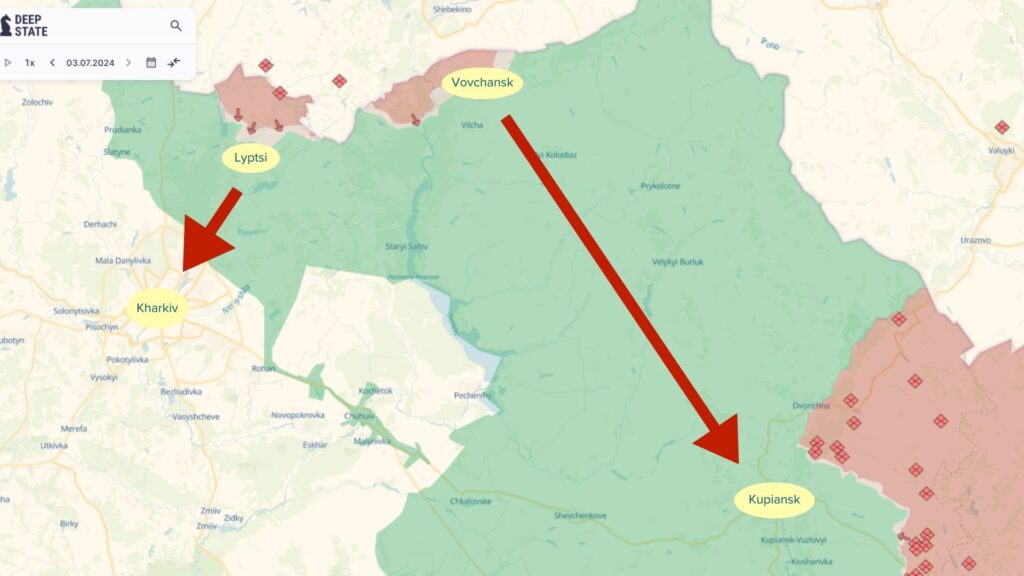
Despite ongoing fighting, neither objective was achieved, and the threat of a breakthrough has subsided.
“We can’t say the Russian Kharkiv offensive has completely stalled, as they wouldn’t be attempting counterattacks if it had. But we can draw an interim conclusion that this offensive operation hasn’t achieved its planned objectives,” Ukrainian defense expert Ivan Kyrychevskyi told Euromaidan Press.
In an exclusive interview with Euromaidan Press, Kyrychevskyi revealed that Ukraine’s NATO-standard air support tactics, not Western permission to use supplied weapons on Russian soil, was the key factor behind Russia’s failures in Kharkiv Oblast.
Target 1: Russia aimed to create a “buffer/sanitary zone”
Putin claimed Russia’s Kharkiv offensive aimed to create a “sanitary zone” protecting Russian border regions from Ukrainian shelling, not to occupy the city of Kharkiv.
“We’re creating security zones. A sanitary zone. But for Kharkiv, there are no such plans at present,” he stated on 17 May.
Ukrainian defense expert Kyrychevskyi explains that Russians view a “sanitary zone” as an area devoid of life.
“This means destroying the city of Kharkiv as a metropolis, industrial center, and transport hub. It’s not about a ‘polite’ occupation with checkpoints,” he told Euromaidan Press.
If Russians had broken through near Lyptsi, they could have brought Soviet 203mm self-propelled howitzers Pion within range of the city of Kharkiv. These fire 40km, with 200kg shells – almost the size of an S-300 warhead.
“Pion fires once every two minutes. Imagine how much more intensively Russians could shell the city of Kharkiv compared to now. Currently, they can’t hit it with 40km-range artillery,” the expert clarified.
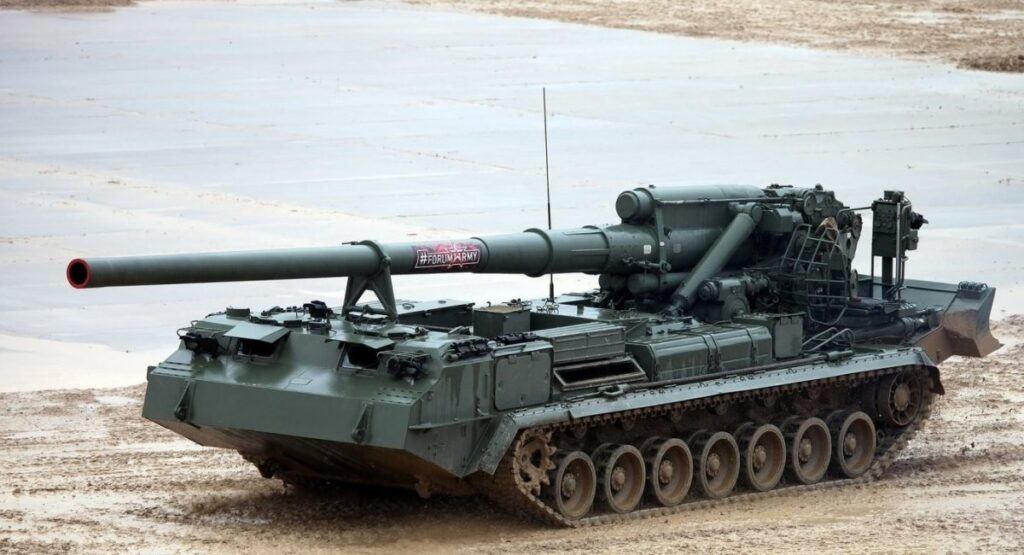
However, Russia diluted its offensive power by simultaneously advancing on two fronts: towards Kupiansk via Vovchansk, and towards the city of Kharkiv through Lyptsi. This approach stretched their forces, compromising both operations.
“The Russians thought Ukrainian forces wouldn’t have enough resources, but they’ve outsmarted themselves,” Kyrychevskyi concludes.
Target 2: Russia wanted the city of Kharkiv
Despite Putin’s denials, Kyrychevskyi notes that Russian actions indicate a desire to capture the city of Kharkiv.
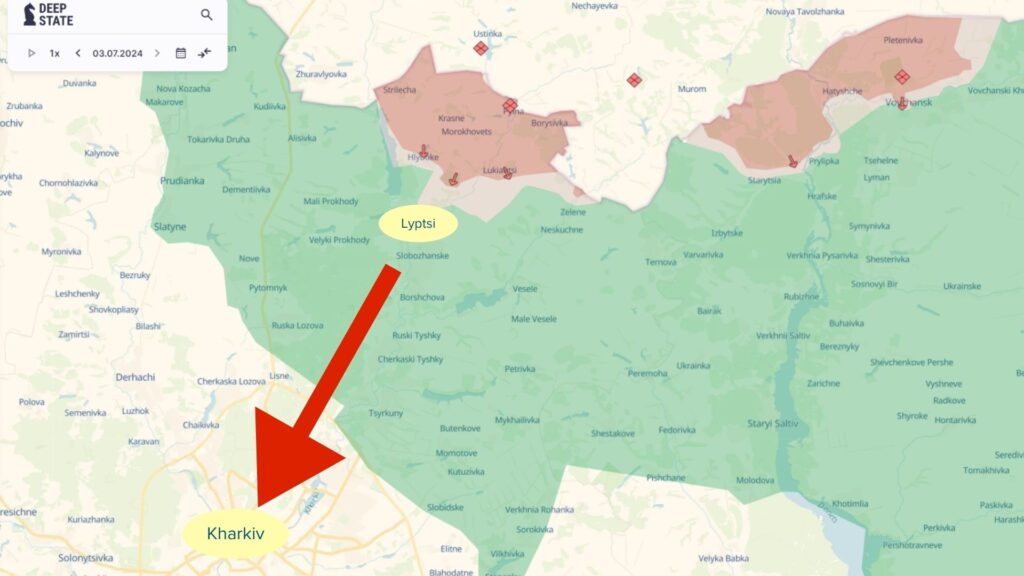
Initially, their offensive targeted Lyptsi to advance towards Kharkiv, but this failed. Although they couldn’t capture the city, Russians continue to bombard it with guided air bombs (KABs) using aviation to compensate for their lack of ground progress.
“Russia’s persistent shelling of the city of Kharkiv stems from their air superiority and Ukraine’s lack of air defenses, not their ground operations,” Kyrychevskyi explains.
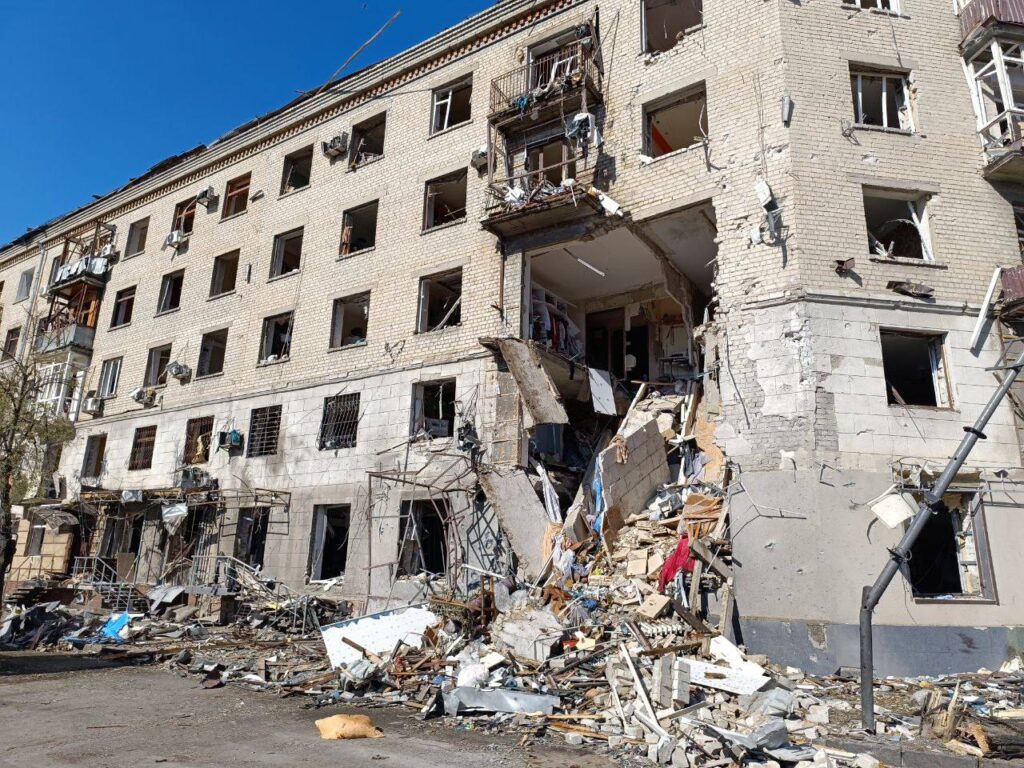
Ukraine still faces a significant air defense challenge. According to 2019 calculations by the Ukrainian military, protecting Kyiv alone requires 4 Patriot batteries with 6-8 launchers each, a $4 billion investment. The city of Kharkiv likely needs an additional 4 batteries. Due to its vast territory, Ukraine must spread its limited air defenses thinly across the country.
Target 3: Russia sought to draw Ukrainian forces from the east to the north
President Zelenskyy stated that Russia’s goal in Kharkiv Oblast is to draw Ukrainian forces north.
“Russia’s intention is clear: to draw our forces northward to facilitate their eastern advance,” he said on 19 May.
Kyrychevskyi notes that this strategy makes sense. However, it isn’t clearly succeeding, despite Ukraine deploying the 38th Marine Brigade to Vovchansk for counterattacks.
Russian success would have extended the active front by 100 kilometers, adding to the existing 1300 kilometers. However, their advance has been halted, failing to achieve any objectives so far.
Two simultaneous Russian attempts in the east – assaults towards Toretsk in Donetsk Oblast and amassing 10,000 troops in Luhansk Oblast to attack Borova in Kharkiv Oblast – suggest their aim to weaken Ukrainian forces. However, Kyrychevskyi cautions it’s too early to assess the success of these attempts.
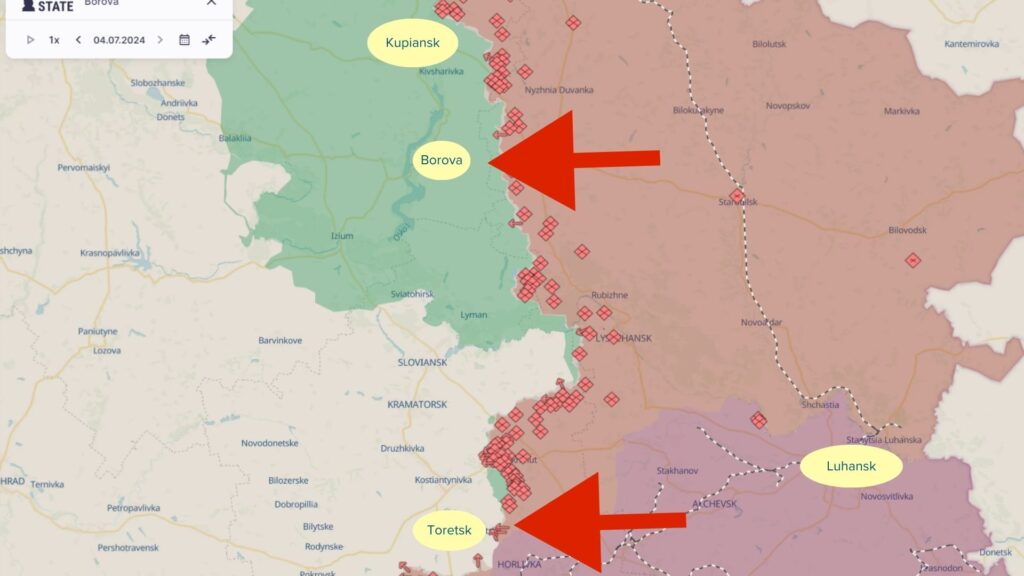
The expert believes that the main objective for the Russians were territorial gains.
“If drawing Ukrainian forces north was their main objective, Russians wouldn’t commit war crimes against civilians in occupied Vovchansk. They’re interested in full occupation, not just hybrid or diversionary tactics,” Kyrychevskyi notes.
Russia’s commitment is evident in their formation of a new army corps within the Leningrad Military District for this offensive.
“Now, the 11th and 44th army corps can’t threaten NATO in the Baltics or Scandinavia because many of their troops died in Kharkiv Oblast,” Kyrychevskyi explains, highlighting the significant resources Russia has invested in this operation.
Why Russia’s offensive in Kharkiv Oblast failed
Kyrychevskyi attributes Russia’s failure in Kharkiv Oblast to two factors:
- Russia made a strategic error in dispersing resources.
- Ukraine has successfully integrated NATO-standard air support tactics with adapted Soviet-era aircraft, utilizing Western guided bombs such as the American GBU-39, JDAM, and the French AASM.
The permission to use Western weapons on Russian territory didn’t play a role in halting the Russian advance, as it came after the Russians were already stopped, says the expert. However, it may help push Russians back to their initial positions.
“Striking the Russian supply echelon on their territory could force a retreat,” Kyrychevskyi explains.
He disagrees with the notion that Russia’s setback in Kharkiv Oblast means the Kremlin won’t attempt similar operations soon, for example in neighboring Sumy Oblast.
“I wouldn’t be so optimistic. At most, we can say that the American permission to strike border targets in Russia is designed for such a scenario,” he cautions.
The expert emphasizes that Ukraine still grapples with the impact of delayed Western military aid, which has created a negative effect that can’t be quickly reversed. Meanwhile, Western allies publicly criticized Ukraine for insufficient mobilization, ignoring the lack of equipment for new recruits.
“Without Western weapons, Ukrainian soldiers fought with Stalin-era guns. You can mobilize people, but what do you equip them with?” Kyrychevskyi points out.
He emphasizes the need to catch up on troop deployment, training, and re-equipping, estimating an optimistic timeline of six months.
Meanwhile, Russians continue to advance slowly. In two months, they’ve moved 3 kilometers closer to the strategic Pokrovsk-Kostiantynivka road, now just 7 kilometers away.

Ukraine’s path to victory: demand more, demand louder
Kyrychevskyi argues the West lacks a coherent strategy for the Ukraine war, historically never aiming for Russia’s decisive defeat.
“The West seems content to bleed Russia slowly at Ukraine’s expense, rather than dealing a decisive blow before Ukrainian demographic resources are exhausted,” he notes.
He points out that at the current rate of Russian advance—3 kilometers in two months in Donetsk Oblast—it would take decades to reach the NATO border. This could be the West’s calculation.
“The West asks Ukraine to pay for this strategy with our most valuable asset — the lives of our people. In return, we ask for resources that don’t belong to us,” Kyrychevskyi says.
He argues that Ukraine’s requests are too modest. The maximum demand is for ATACMS to strike Russian territory, despite their insufficient range to hit crucial targets like long-range missile production facilities.
“Why aren’t we asking for truly long-range weapons like Tomahawk missiles, which the Americans are already selling to their allies for $4 million each? This needs to be done publicly,” the expert suggests.
He explains that some of Ukraine’s public complaints, such as about Germany’s reluctance to provide Taurus missiles, overlook nuanced realities.
“Britain and France, with their nuclear arsenals, can afford to provide Ukraine with long-range missiles like StormShadow. Germany, lacking a nuclear deterrent and with only about 200 operational Taurus missiles, faces different strategic constraints,” he explains.
Kyrychevskyi advocates for Ukraine to broaden its requests, including US THAAD systems capable of intercepting ballistic missiles at 600 km range. With them, Ukraine could intercept Russian ballistic missiles early in their flight, not just over Kyiv where debris still causes damage.
“Ukraine needs a public campaign demanding a wide range of advanced weaponry and pressuring the West for more substantial support,” he concludes.
*****
Russia’s Kharkiv Oblast offensive failed due to strategic errors and effective Ukrainian air tactics. Dispersing resources and underestimating Ukraine left Russian forces unable to achieve their objectives. Western permission for Ukraine to use supplied weapons on Russian territory came too late for this offensive but may impact future operations.
Defense expert Ivan Kyrychevskyi argues current Western aid can’t secure Ukraine’s victory or retake Crimea. He contends Ukraine needs far more resources – hundreds of aircraft, advanced missiles, and thousands of tanks and fighting vehicles – to counter Russia’s advantages.
Read more:
- ISW: Ukrainian forces recaptured positions in northern Kharkiv Oblast
- Russian air strike on Kharkiv injures 14, including infant
- The NYT: Russia’s “meat grinder” tactic leads to high casualties among its troops and lack of significant gains in Kharkiv
- Dozens of Russian soldiers trapped in Kharkiv’s Vovchansk factory
- ISW: Russia may intend to leverage ongoing Toretsk push for advances in Chasiv Yar or Avdiivka areas
You could close this page. Or you could join our community and help us produce more materials like this.
We keep our reporting open and accessible to everyone because we believe in the power of free information. This is why our small, cost-effective team depends on the support of readers like you to bring deliver timely news, quality analysis, and on-the-ground reports about Russia's war against Ukraine and Ukraine's struggle to build a democratic society.
A little bit goes a long way: for as little as the cost of one cup of coffee a month, you can help build bridges between Ukraine and the rest of the world, plus become a co-creator and vote for topics we should cover next. Become a patron or see other ways to support.


